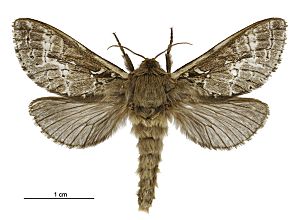Porina moth facts for kids
Quick facts for kids Porina moth |
|
|---|---|
 |
|
| Female specimen | |
 |
|
| Male specimen | |
| Scientific classification | |
| Synonyms | |
|
The porina moth, also known as Wiseana cervinata, is a special type of moth. It belongs to a family of moths called Hepialidae. This moth was first described by a scientist named Francis Walker in 1865. You can only find the porina moth in New Zealand, which means it is endemic to that country.
Contents
Discovering the Porina Moth
The porina moth was officially named and described in 1865. This was done by Francis Walker, an important entomologist (a scientist who studies insects). He gave it the scientific name Wiseana cervinata.
What Porina Moths Look Like
Porina moths have different sizes depending on if they are male or female. The wingspan (the distance from one wingtip to the other when the wings are spread out) of male moths is usually between 34 and 38 millimeters. Female moths are larger, with a wingspan of 44 to 55 millimeters.
Wing Colors
The color of the front wings of the porina moth can change a lot. They can be a light tan color, or they can be much darker, almost black. This variation helps them blend into their surroundings.
When Moths Are Active
Adult porina moths can be seen flying around from September to March. This is the time of year when they are active and looking for mates.
Life Cycle and Diet
Like many insects, the porina moth goes through different stages in its life. The young moths, called larvae (which are like caterpillars), spend their time eating.
What Larvae Eat
The larvae of the porina moth mainly feed on different types of plants. They enjoy eating various species of clover, which is a plant often found in fields. They also eat many kinds of grasses. This diet helps them grow and get ready for the next stage of their life cycle.

